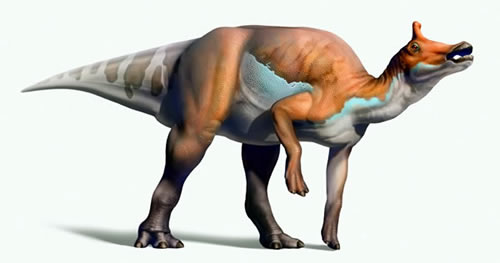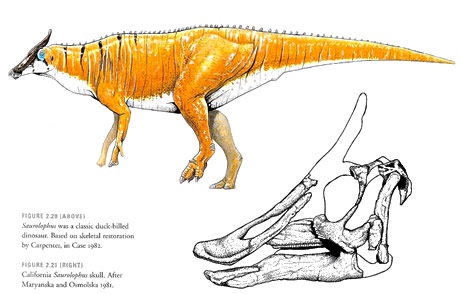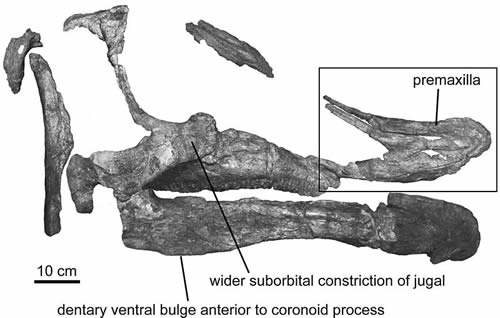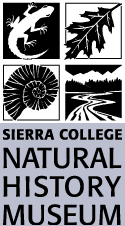Augustynolophus morrisi
Richard P. Hilton and Joe Medeiros
Sierra College

One of the most recent additions to the growing list of California state symbols is that of an official State Dinosaur. Not to be confused with wooly mammoths, saber-toothed cats, ground sloths and other Ice Age animals, dinosaurs existed much earlier in time. They were a very diversified group of terrestrial reptiles, varying in size from quite small to enormous—just ask any 2nd grader, they’ll fill in the details for you! Dinosaurs reigned supreme for over 150 million years during the Mesozoic Era. A massive extinction brought forth by the impact of an asteroid or comet on the Yucatan Peninsula of Mexico 66 million years ago signaled their end.
Having a State Dinosaur is not new, in fact ours is the ninth to be added to the lists of symbols of various American states, but ours may prove to be quite unique. The only known specimens of our dinosaur are from California (so far), which makes it endemic to what is now California.
Making It Official
California State Assemblyman Richard H. Bloom of Santa Monica introduced AB 1540 (co-authored by members Anna Caballero and Reggie Jones-Sawyer) making Augustynolophus morrisi the official California State Dinosaur. In September of 2017, Governor Jerry Brown signed the bill making it official.
Augustynolophus is new to science but not to history. It was first discovered during 1939-40 by research teams from the California Institute of Technology. While working in the Moreno Formation in the Panoche Hills (western Fresno County) specimens of a peculiar dinosaur were unearthed. Until recently the specimens were thought to be the same species as others found along the Pacific Coast. Intensive studies reveal that Augustynolophus morrisi is distinctly different (starting with the cranium) and deserves its own genus and species status.
It's a Hadrosaur
Augustynolophus morrisi (we can’t help but think this sounds like Sesame Street’s “Mr. Snuffleupagus”) is a hadrosaur, one of the more common types of dinosaurs of western North America. These “duck-billed” dinosaurs had a duck-like snout, toothless in front, but with rows of grinding teeth at the rear of their jaws. The self-replacing grinding teeth are those of a vegetarian that could chew even coarse vegetation. They probably died (possibly drowned) in the ancestral Sierra Nevada and washed out to sea at river mouths before sinking to the bottom to be covered with muddy sediments.
They had curious, boney spike-like crests atop their skulls, thought by some to be for sexual display, defense, or possibly (since they were hollow and flute-like) to amplify and resonate sounds for communication. Hadrosaurs were bipedal while walking but would use all four limbs when feeding. Our specimen was moderately-sized, about 30 feet long (head to tail) and stood about 10 feet tall.

Where Did That Name Come From?
Augustynolophus morrisi takes its scientific name from Gretchen Augustyn, whose family includes major supporters of the Los Angeles County Museum, and from paleontologist William Morris who excavated numerous dinosaurs in Baja California. While these two names are important in the world of paleontology, we must also remember and recognize the significant efforts of Chester Stock, whose teams worked tirelessly in the Panoche Hills in the late 1930s and early 1940s.
They discovered Augustynolophus morrisi and many other reptilian remains. The first of two specimens was found by team member Betty Jean Smith in 1939, while the other was found by Art Drescher and Bob Leard in 1943. These discoveries produced the most complete dinosaur skeletal remains found in California.

-
California State Dinosaur News Links
- http://www.mercurynews.com/2017/09/25/at-last-california-has-an-official-state-dinosaur/
- http://www.latimes.com/politics/la-me-ln-california-state-dinosaur-20170923-story.html
- https://www.smithsonianmag.com/smart-news/meet-augustynolophus-morrisi-californias-new-state-dinosaur-180965038/
- https://www.scpr.org/news/2017/09/23/75943/california-has-an-official-state-dinosaur/
- http://mentalfloss.com/article/49144/8-official-state-dinosaurs
- https://statesymbolsusa.org/symbol-official-item/california/dinosaurs-fossils/augustynolophus-morrisi
Resources
- Drawing of Augustynolophus credit: © Courtesy of the Natural History Museum of Los Angeles County.
- State symbols: dinosaurs and/or fossils
https://statesymbolsusa.org/categories/dinosaur-or-fossil - California state symbols
http://www.library.ca.gov/history/symbols.html - Hilton, Richard P. Dinosaurs and Other Mesozoic Reptiles of California. UC Press, Berkeley. 2003.
- Skull: http://app.pan.pl/article/item/app20110049.html
- Saurolophus painting, Hilton, Dinosaurs and Other Mesozoic Reptiles of California
- Augustynolophus (formerly Saurolophus) morrisi skull. Photo by Albert Prieto-Márquez and Jonathan R. Wagner / Wikipedia (use permitted with attribution).
